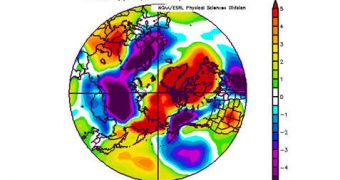A team of experts believes it may have found a good explanation for the extreme bouts of winter weather that swept through the United States and Europe late last year and in early 2011. They say that a deterioration of the Polar Vortex may be to blame for the unusual weather patterns.
Lately, the Northern Hemisphere has been swept by extremely cold winds, and a large number of areas have been hit by massive snowstorms. In all respects, it seemed like the Northern continents were getting colder all of the sudden.
At the same time, the Arctic was surprisingly getting warmer. This is very counterintuitive, experts say, pointing out that such an occurrence is unnatural, and that it shouldn't have happened at all.
The conclusions belong to a study carried out by experts with the Seattle-based Pacific Marine Environmental Laboratory (PMEL). The team was led by scientist Dr. James Overland.
The PMEL is managed by the US National Oceanic and Atmospheric Administration (NOAA). Dr. Overland has extensive expertise in understanding the North Pole, as he has been monitoring and studying it for the past 30 years or so.
“When the Polar Vortex (a ring of winds circling the Arctic) breaks down, this allows cold air to spill south, affecting the eastern United States and other regions,” the expert says of the bad weather.
“This can result in a warmer-than-average Arctic region and colder temperatures that may include severe winter weather events on the North American and European continents,” he goes on to say.
Readings collected between 1968–1996 show the Polar Vortex remaining string throughout, keeping cold air within the Arctic region. However, in the winter of 2009–2010, it finally gave way.
As such, large masses of freezing air could travel southwards, affecting Europe, Russia, Canada, and the United States. Experts say that the action of the Polar Vortex was teased out from statistical data after compensating for the effects of natural climate variability.
“In December 2009, the Arctic was 9 degrees F warmer than normal, and mid-latitude continents were 9 degrees F cooler than normal, with record cold and snow conditions in northern Europe, eastern Asia and eastern North America,” Dr. Overland explains.
“This is the Warm Arctic-Cold Continents pattern. The winter of 2009–2010 had especially extreme weather in the U.S. as moisture from El Nino hit cold air from the Arctic,” he concludes.

 14 DAY TRIAL //
14 DAY TRIAL //